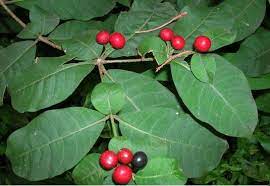SARPAGANDHA

listen about me
Rauvolfia serpentina (L.) Benth. ex Kurz
Classification:
Kingdom: Plantae
Division: Angiospermae
Class: Gamopetalae
Subclass: Gamopetalae
Series: Bicarpelatae
Order: Gentianales
Family: Apocynaceae
Genus: Rauvolfia
Species: serpentina
Scientific Name: Rauvolfia serpentina (L.) Benth. ex Kurz
Common Name-
English: Indian Snakeroot, Insanity herb
Hindi: Sarpagandha सर्पगंधा
Kannada: ಸೂತ್ರನಾಭಿ Sootranaabhi, ಶಿವನಾಭಿ Shivanaabhi, ಹಡಕಿ Hadaki, ಸರ್ಪಗಂಧಿ, Sarpagandhi
Manipur: Chandrabhaga
Description:
Sarpagandha is an erect, evergreen shrub, merely 15 to 45 cm high. Its leaves are large, in whorls of three – dark green above and pale green below. The flowers are white, pinkish or red, occurring in whorls. Its fruit are tiny, oval, fleshy which turn a shiny purple-black when ripe. It is the roots of the plant that are mainly used for medicinal purposes.
Uses:
1) Sarpagandha is a famous tranquilizer and antipsychotic herb of India for the treatment of paranoia and schizophrenia, as well as a substance that controls hypertension.
2) Although this plant was well known in India, westerners paid no attention to it until an Indian physician Rustom Jal Vakil, wrote an article on rauvolfia in 1943. Because of the drugs noted sedative effects, it was used to treat over a million Indians in the 1940s for high blood pressure.
After a U.S. physician named Wilkins demonstrated the positive effects of reserpine (1952), the plant made front page news. This drug rapidly replaced electric shock and lobotomy as treatments for certain types of mental illness. Moreover, knowledge about the chemistry of this natural plant stimulated the synthesis of other similar alkaloids that are now used as major tranquilizers.
